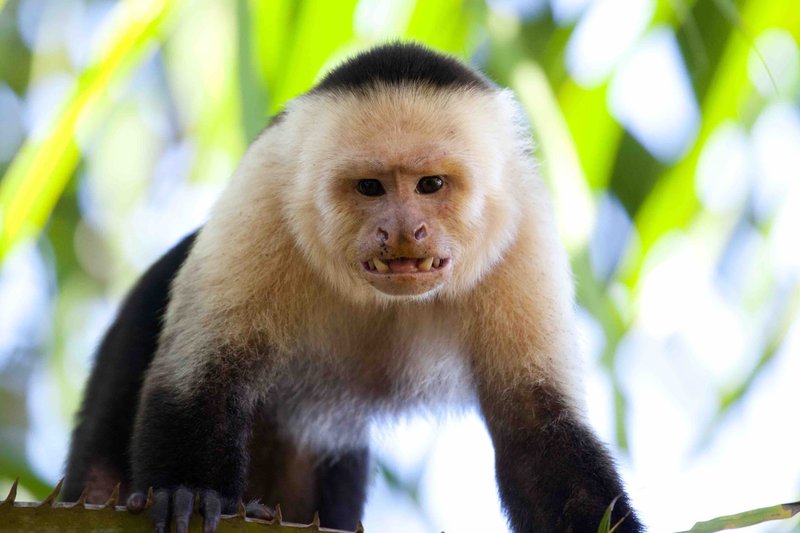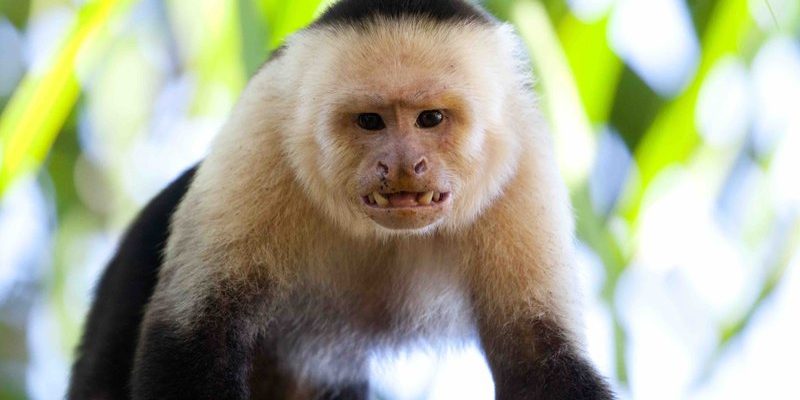
Capuchin monkeys are often recognized for their striking features, like their creamy-white faces contrasted against dark fur and their prehensile tails that act like extra hands. They are native to Central and South America and are named after the Capuchin friars, due to the resemblance of their coloring to the monks’ robes. Let’s dive into some captivating facts that make capuchin monkeys one of nature’s most intriguing primates.
1. They’re Super Smart
Capuchin monkeys are often praised for their remarkable intelligence. They can solve problems, use tools, and even learn new tricks quickly. Here’s the thing: when researchers study animal intelligence, capuchins often rank near the top, comparable to chimpanzees.
For example, these clever monkeys have been observed using sticks to extract insects from tree bark. They can also use stones to crack open hard-shelled nuts. This ability to use tools isn’t just a fun fact; it shows how adaptable and resourceful they are in the wild, much like how humans have learned to manipulate their environment for survival.
2. They Have Unique Social Structures
Capuchin monkeys are highly social animals and live in groups ranging from 10 to 30 individuals. Now, you might be wondering why social life matters for these creatures. Well, their social structures are complex, with strong bonds forming between family members.
These monkeys communicate through a variety of vocalizations, body language, and facial expressions, creating intricate social interactions. Imagine a family gathering where everyone is sharing news, playing games, and even arguing a bit—that’s how capuchin communities operate. Within these groups, they also exhibit grooming behavior, which helps strengthen social bonds and maintain harmony.
3. Their Diet is Diverse
Capuchin monkeys are omnivores, meaning they eat a wide range of foods. They enjoy fruits, nuts, insects, and even small vertebrates. This varied diet is essential for their survival, especially in the wild where food availability can change.
Think of them as nature’s little chefs—Capuchins will forage for a variety of ingredients depending on the season. They have been observed picking ripe fruits from trees, digging into the ground for roots, and even foraging for small animals. Their flexibility in diet not only helps them thrive but also showcases their role in maintaining the ecosystem, spreading seeds through their droppings.
4. They’re Great Climbers
If you’ve ever seen a capuchin monkey in action, you know they’re incredible climbers. Their strong limbs and prehensile tails allow them to navigate the treetops with ease. This climbing ability is crucial for both foraging and escaping predators.
Imagine them darting from branch to branch, leaping with agility that would make Olympic gymnasts jealous. Their tails are like an extra hand, helping them balance and hold onto branches while they move. This adaptation allows capuchins to explore their habitats fully, searching for food or evading danger.
5. Capuchins Have a Rich History in Research
Capuchin monkeys have played a significant role in scientific research, particularly in studies about primate behavior and cognition. Their intelligence and social behaviors provide insights into the roots of human behavior. Researchers have used capuchins to explore various topics, from tool use to the development of social structures.
In many ways, these monkeys are like a living laboratory, helping scientists understand our own species. By observing capuchins, researchers can draw parallels between human and monkey behaviors, which helps deepen our understanding of evolution and social dynamics.
6. They Use Tools Like Pros
We touched on capuchins’ tool-using skills earlier, but it deserves a closer look. Tool use among animals is rare, and capuchins have developed quite a few techniques. Whether it’s using rocks to crack nuts or sticks to reach insects, these monkeys are innovative problem solvers.
Imagine a group of capuchins working together to get a tough nut open. They’ll often select the heaviest rocks available to do the job, showcasing not just intelligence but a learned behavior passed down through generations. This cultural transmission of knowledge mirrors how humans teach their children, emphasizing the cognitive abilities that capuchins possess.
7. They’re Popular in Pop Culture
You might have seen capuchins in movies, TV shows, or even as beloved characters in video games. Their playful nature and expressive faces make them favorites among filmmakers and audiences alike.
One of the most famous capuchins is Marcel from the popular TV show *Friends*. Characters like Marcel often pique our interest in capuchins, showcasing their intelligent and mischievous behavior. This portrayal has not only entertained but also educated people about these fascinating creatures, though it’s essential to remember that in real life, capuchins require specific care and their natural environment.
8. Their Conservation Status is Important
While capuchin monkeys are widespread, they face threats from habitat loss and hunting. Deforestation and land development are significant challenges, as these activities reduce their natural habitats.
Conservation efforts are crucial to ensuring capuchins thrive in the wild. Various organizations work to protect their habitats and educate communities about sustainable practices. When you think about it, protecting these monkeys isn’t just about safeguarding one species; it’s about preserving the entire ecosystem they help support.
9. They Have a Strong Sense of Family
Family bonds are extremely important for capuchin monkeys. They usually live in matrilineal groups where females play a key role in raising the young. Mothers are very nurturing, teaching their offspring essential life skills and social behaviors.
Watching a mother capuchin care for her young provides insight into their family dynamics. The way they interact mirrors human parent-child relationships in many ways. You’ll often see mothers groom their babies or carry them on their backs, showcasing their protective nature.
10. They Are Nature’s Entertainers
Capuchins are known for their playful antics. They love to chase each other around, swing from branches, and explore their surroundings. This playful behavior isn’t just fun to watch; it plays a vital role in their development and socialization.
Just like kids at play, capuchins learn important skills through their playful interactions. Whether it’s learning how to climb or establishing social hierarchies within their groups, this playful spirit is essential for their growth and happiness.
In conclusion, capuchin monkeys are truly remarkable creatures. Their intelligence, social structures, and playful personalities make them a joy to learn about. By understanding and appreciating these fascinating monkeys, we not only enrich our own lives but also contribute to the conservation of their species and habitat. Whether they’re swinging through trees or being stars in our favorite shows, capuchins remind us of the beauty and complexity of nature.

